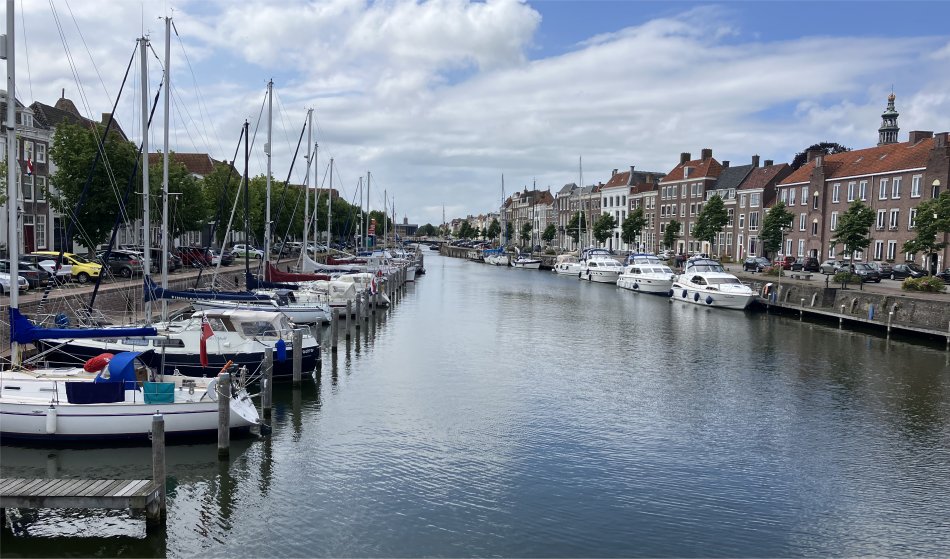 Binnenhaven |
I went off to have a shower, and spotted the harbour master closing the Spijkerbrug. I approached her and asked, "Excuse me, but do the Marechaussee stamp passports here?"
"Yes, they do," she replied.
"That's great. And do you know the times when the canal bridges open?"
"Yes, and it is good that you asked since some of the times have changed and are new to us. I have them at the office, follow me and you can write them down. We open the Spijkerbrug 22 minutes before the main bridges open. Do you want the Marechaussee today? I can call them now if you want."
"No, we don't intend to leave until tomorrow," I replied.
"OK. If you let me know when you are leaving tomorrow, I will call them today."
I thanked the lady, and returned to share the good news with Rex. This would save a lot of messing about at either Vlissingen or Breskens, and the need to negotiate with harbour masters to temporarily tie up in their marinas.
Rex had a chat with Steve Warner from Tollesbury, who owned the Grand Banks boat. The chap had spent six years refurbishing the boat, and had kept it at Levington for a while.. He now keeps it in Holland, where he lives most of the time. He gave Rex a run down on the history of Grand Banks boats. He pointed out another UK boat a few berths down. That belonged to a lady from Maldon. She was coming across soon to visit him he stated, with a twinkle in his eye.
Here in the Binnehaven we were surrounded by the old city. The Binnenhaven was bounded by Londensekaai (London Quay), Houtkaai (Wood Quay), Bierkaai (Beer Quay) and Korendijk (Corn Dyke,) the names ringing with the sound of riches that used to pour through Middelburg when it was a port of call for the Dutch East Indies Company.
The historic town of Middelburg is the provincial capital of Zeeland. The town owes its name to the fact that it was Walcheren's central circular defences (burg meaning fort), a fortification built low down behind a circle of high embankments. These fortifications protected the residents from intruders, such as the Vikings. The first abbey was built in 844, and was replaced by a new one in 1125. Middelburg was part of the County of Zeeland, which was soon to be disputed by the Counts of Holland and those of Flanders. The city was granted city rights in 1217. In 1299, Holland and Zeeland both passed to the Counts of Hainaut, then to the Wittelsbach of Bavaria in 1345, to the Dukes of Burgundy a century later, and finally to the Habsburgs. The town continued to gain in power and prestige during the 13th and 14th centuries. In the Eighty Years' War (1568-1648) the northern provinces of the original Low Countries won their independence from their former Spanish Habsburg rulers and formed The Netherlands, a Protestant state. Later, in the 17th century (the Dutch Golden Age), Middelburg became, after Amsterdam, the most important centre for the East India Company of Republic of the Seven United Netherlands (VOC) or Dutch East India Company. Middelburg became a major trading city between England and the cities of Flanders (e.g. Ghent and Bruges), then, from 17th century, for the Dutch East India Company, the first international Corporate in the world. The small city had been the administrative capital of the province for a long time, but it had lost most of its attraction when other towns were booming during the last few centuries. Much of the city was destroyed by German bombing in May 1940, but most of the historical buildings were reconstructed afterwards.
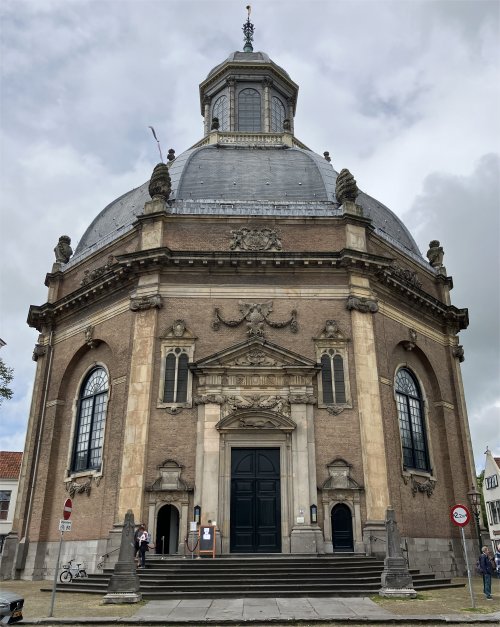 Oostkerk |
Middelburg experienced a growth spurt at the end of the 16th century. The flourishing port city attracted large numbers of immigrants and the city had to expand to provide them with a home. This happened on the east side of the then buildings. Streets such as Brakstraat, Breestraat, Schuitvlotstraat and Verwerijstraat date from that time.
In the mid-seventeenth century, a church was planned in the new city district. The need for it was great now that the number of inhabitants had grown so much. The new church had to be located at the end of Schuitvlotstraat. The front was oriented towards the Breestraat, directly opposite the Dampoort. The site was located exactly in the axis of the harbour canal that was dug in 1532. To create a square there, the city bought a number of houses on site and had them demolished.
The Hague architect Bartholomeus Fransz. Drifthout was responsible for the design of the church. This took the shape of an octagonal domed church. On September 15th, 1648, six sons of Middelburg city councillors laid the first stone.
The Oostkerk was the first church in Middelburg that was built specifically for Protestant worship. The other existing churches dated from the Middle Ages and were assigned to the Reformed after the Reformation. The city council spent a fortune on the construction of the church and incurred considerable debt for this. In addition to a legacy, construction was financed by a loan. The interest that was due annually put a heavy burden on the city's finances. The city council therefore doubled the tax on beer and wine and the 'hundredth penny' on houses, a real estate tax.
This church with the round dome has stood out in the silhouette of Middelburg for centuries. It arose at a time when the city was doing well and survived the centuries that followed virtually unscathed. Nowadays the building provides a stage for cultural events.
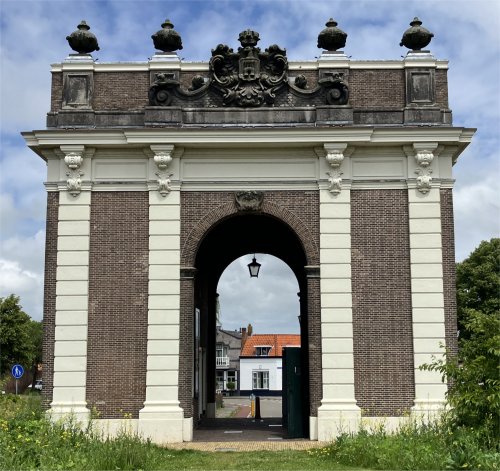 Koepoort |
Inside the arch, a couple of old unadorned doors provided access to the interior of the monument. Nowadays you can spend the night in the B&B located in the Koepoort.
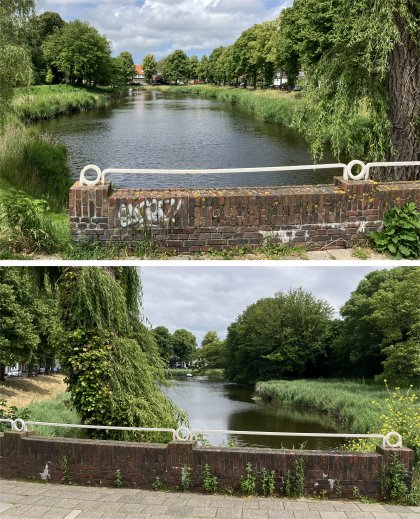 Views Either Side of Koepoortbrug |
In 1127 Norbertine came to Middelburg. These monks were followers of Norbert of Xanten. They established here the Premonstratensian from St. Michael's Abbey in Antwerp. For four centuries (until 1570) the monks worked on their Norbertine abbey. They expanded the complex into what it was today: churches, religious spaces, cloisters, stair towers and vaults. It was like a ring of impressive architecture around the central Abdijplein (Abbey Square). The whole was crowned by the 91m tall abbey tower, "Lange Jan" (Tall John), regarded by many as the ultimate symbol of Middelburg. Three churches were contained in a cluster in the complex: the 14th-century Koorkerk (Choir Church), the 16th-century Nieuwe Kerk (New Church) with a famous 16th century organ, and the 17th-century Wandelkerk which held the tombs of Jan and Cornelis Evertsen, admirals and brothers killed fighting the English in 1666. The northern section housed the Zeeuws Museum, renovated in 2007 by a well-known Belgian architect. The museum had fine collections of china, silver and paintings, and tapestries. The vast inner courtyard, the Abdijplein, behind the churches was immaculate, as to be expected in the Netherlands, and echoed of history. Tall trees stood proudly waving in the breeze, and ancient gates led out into the old city.
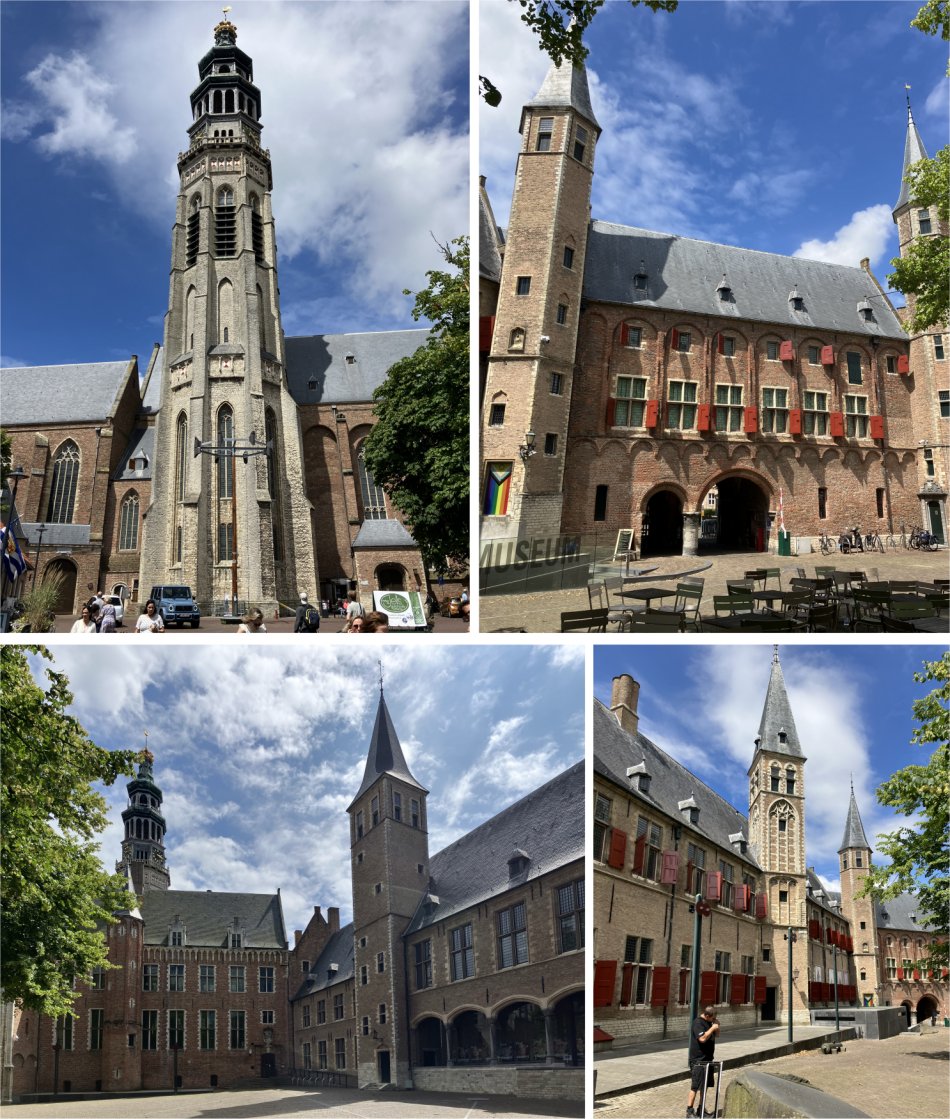 Abdijplein |
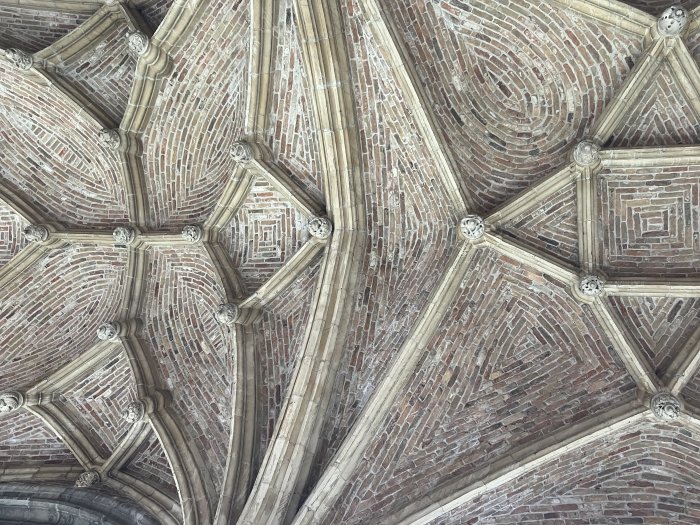 Vaulted Cloister Ceilings |
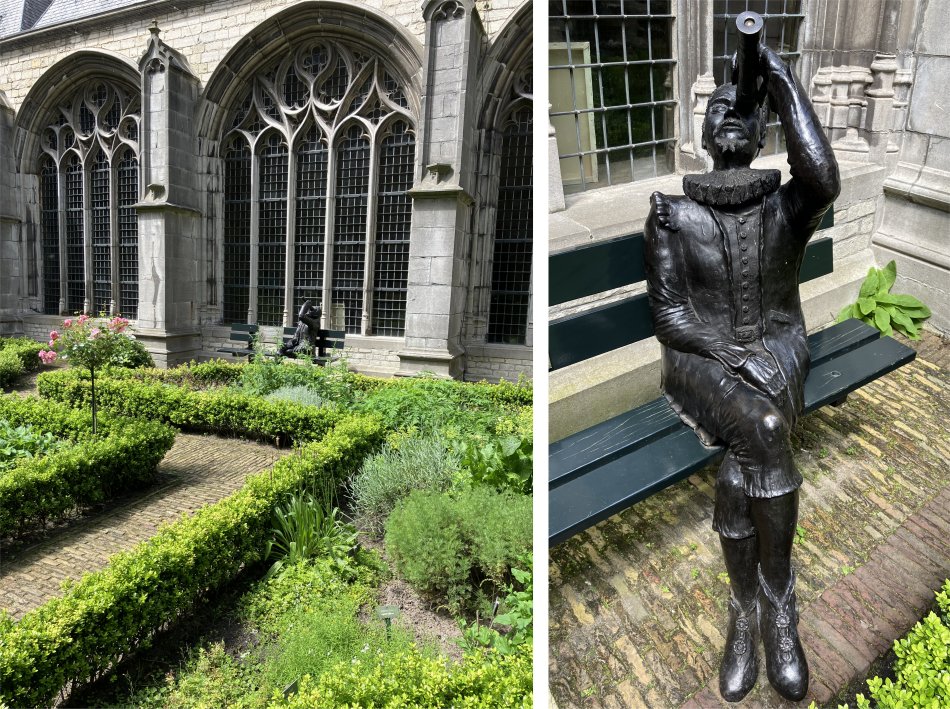 Kloostertuin |
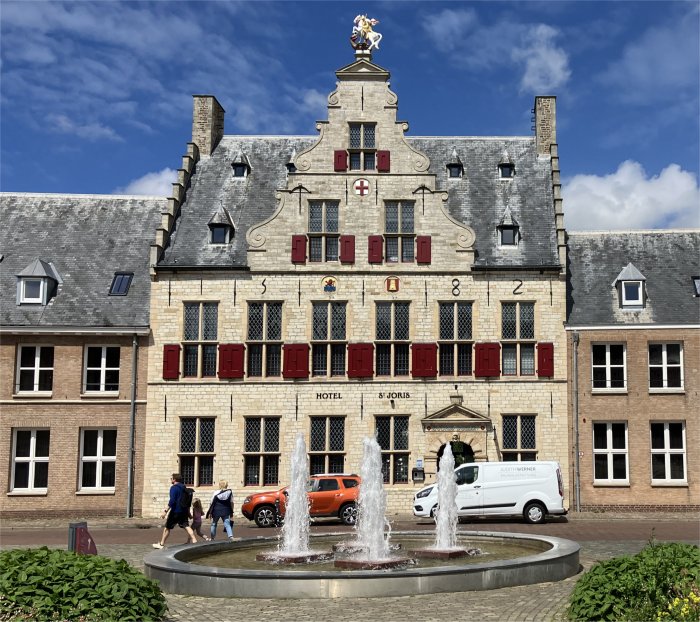 Hotel St Joris |
Now we turned left along Wagenaarstraat, Hofplein, and Lange Noordstraat. It soon became apparent that the centre of Middelburg contained two concentric rings of streets, on the line of the old grachten constructed to strengthen the town's defences as it grew steadily larger over the centuries. From these inner rings a number of streets lead out to a U-shaped outer circuit of grachten with the open end to the north. Farther out again was the line of the old fortifications, bounded on the south side by the Kanaal door Walcheren, which linked the town with the open sea.
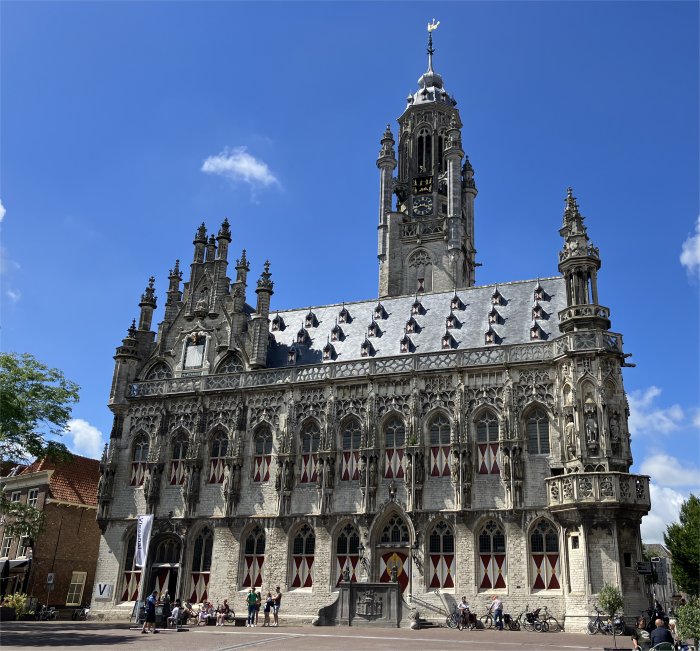 Stadhuis |
We ambled down Vlasmarkt, and took a left down Beddewijkstraat. It was in this street we stopped for a much-needed rest and refreshment. Inside a small café two old men were having a meaningful conversation at the bar, completely ignoring one of the Euro 2024 matches on the large screen TV. We both opted to sit outside and spoiled ourselves with apple pie and cream with our beverages. Another customer outside was accompanied by a large dog. The dog took a fancy to Rex's shoes. Hmmm … perhaps Rex ought to consider wearing socks when he wears footwear, that way dogs would not take a fancy to his odourful footwear.
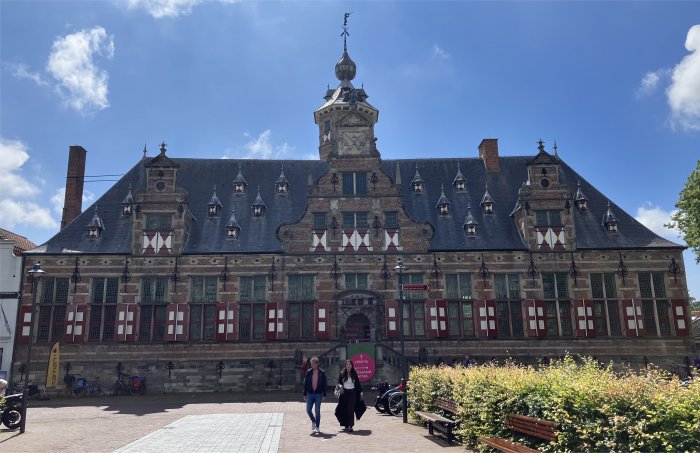 Kloveniersdoelen |
Today, the beautiful building had a very large brick façade striped with white stone and enlivened with red and white shutters, similar to those on the Stadhuis. The central gable, endowed with scrolls, bore a sculpted low-relief of muskets and shot, and was topped with an eagle. Behind, stood an octagonal onion-domed turret bearing a weathervane in the shape of a marksman.
Once back on board Duonita, I got chatting to the Dutch chap who was working on the adjacent boat. He enquired about our journey, and was keen to discover the route we would take back to England. However, he clearly had no idea of English geography.
"We love to visit Middelburg, it is a charming town," we said.
"A lot of it is new," he replied. "One third of the buildings were destroyed during World War II."
"Through bombing by Germans or the Allies?"
"No, the town was full of French soldiers, even after the Netherlands capitulated. The damage came from the fight between the French and Germans."
We left the chap to his work and we headed off for the evening. First port of call was to the harbour master to request the Spijkerbrug be opened at 10:15 the next morning, and also could she organise for the Marechaussee to come and stamp our passports in the morning. With that all sorted out, we could just chill now.
Our next port of call was the Visiting Yacht Club Bar, a popular haunt for sailors visiting the town. Indeed, one year Rex, Meryl, Liz and Dougie spent a very merry evening there, and Rex presented a Mud Club burgee to the club. Following the tradition, this was duly attached to a roof beam, alongside umpteen other burgees from other clubs. Sadly, the club had been totally refurbished, all the bugees removed, and was now a charmless restaurant.
After a token drink there, we returned back to the Markt and visited a different restaurant. The young waitress who served us was partially foiled by my faltering Dutch.
"It's OK, I don't speak good Dutch," she said in perfect English. It didn't take long to discover we were all English. She came from Greenwich in London, and was studying Liberal Arts at the university in Middelburg. "Only about a third of the students on the course are Dutch, the rest come from all around the world, so the course is run in English. I wanted to study Liberal Arts (a pick 'n mix of many diverse subjects), and the only places where you can study that subject are the Netherlands and the USA. I chose Middelburg because it is a really nice, historic town."
"What do you intend to do with your degree?" asked Rex.
"I would like to do a Masters, then perhaps a doctorate. I think I'd like to remain in academia."
"Do you visit family much?"
"My mother lives in France, so I occasionally visit her."
We wished her good luck with her studies and future.
Back on board Duonita, we settled down for the night. However, two chaps were chatting away outside our boat; one quietly spoken, perhaps Steve Warner, and the other a Scotsman with a loud voice. How considerate.
